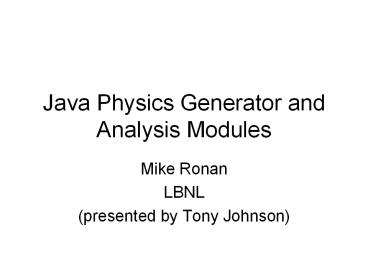Java Physics Generator and Analysis Modules PowerPoint PPT Presentation
Title: Java Physics Generator and Analysis Modules
1
Java Physics Generator and Analysis Modules
- Mike Ronan
- LBNL
- (presented by Tony Johnson)
2
Goals
- Disparate groups working worldwide on Linear
Collider physics studies have produced
complementary tools using a variety of languages
and methodologies - From a physics perspective it is desirable to
directly compare the results from these different
tools - A framework for accessing different modules in a
uniform way has been developed, allowing one
analysis module to be used with all tools - Methodology not specific to linear collider
studies
3
Methodology
- Use Java for building framework
- Good OO language for rapid development of
analysis algorithms - Use Java Native Interface (JNI) to call different
language modules and retrieve results back into
Java objects - Adapt each tool to use common java interfaces
- E.g. All generators create same HEPevt
- Use existing Java analysis tools for data
analysis - JAS, JAIDA, etc.
- US Linear Collider physics tools (Java)
- 3,4 vector tools, jet finders, vertex finding,
etc. - Provide access to Java based scripting languages
- jython, pnuts, dynamic java etc.
4
Event Generators Interfaced
- Pandora-Pythia V2.2 Monte Carlo using
PanoraPythia interface package - C and Fortran 77
- Pythia v6.2 Monte Carlo with Circe beamstrahlung
simulation - Fortran 77
- Whizard V1.22 Monte Carlo with ISR and Circe
turned on - Fortran 95
5
(No Transcript)
6
Implementation
- Use Java native Interface (JNI)
- For interfacing to generators only need to
implement a few methods - setParameter() setProcess()
- init()
- generateEvent()
- getEvent() Access to HEPEvt, common to most
generators - finish()
- Infrastructure can be reused with little change
between generators - Use standard tools (gmake etc.) to build .so file
- Other libraries (i.e. CERNLIB) can be statically
linked into .so file - Rarely needs to be rebuilt
- All interactive work can be done in Java
7
Usage Example
- Details of how to set up generator varies from
generator to generator - All follow same basic pattern
- All generate same set of Java objects
representing generated particles
8
More about HEPEvt classes
HEPEVT Common Block
Java Object Model HEPEvt Particle ParticleType
9
Pandora, Pythia, Whizard Comparisons
- FMCParticle jet distributions
- Number of correctly reconstructed jets
- Angular distribution (Cos?Max) of jets
- Jet finder final ycut
- Direct reconstruction of Z and Higgs through
hadronic decays. - Good agreement between Pandora, Pythia and
Whizard simulation
10
Simulation Packages
- LCD Fast Monte Carlo v1.4 (Java)
- Charged particle momentum smearing based on
detailed error estimates - Gaussian energy smearing for photons and neutral
hadrons - Acceptance and energy threshold requirements
- Perfect energy flow
- TESLA SimDet V4.0 (Fortran 77)
- Parameterized charged and neutral energy smearing
based on full (Brahms) Monte Carlo simulations - Acceptance requirements
- A new energy flow algorithm
- JLC QuickSim V2.1 includes (C)
- Charged particle momentum and position smearing
based on detailed error estimates - Simulation of individual calorimeter cell hits
and cluster finding - Track-cluster association to separate charged and
neutral clusters
11
Interoperability
DetectorSimulation
Event Generators
Pythia
LCD FastMC
Pandora
Event Selection
TESLA SimDet
Analysis Code
Whizard
JLC QuickSim
Java
Fortran
C, C
12
US FastMC, SimDet QuickSim Detector Simulations
- Direct reconstruction of Z and Higgs through
hadronic decays is shown for Higgstrahlung signal
events only. Jet-jet mass distributions for US
FastMC, TESLA SimDet and JLC QuickSim detector
simulations are reconstructed for
Whizard-MadGraph Monte Carlo events including ISR
and Circe beamstrahlung effects. - The LCD FastMC jet-jet mass resolution is
significantly better since it assumes perfect
energy flow. TESLA SimDet and JLC QuickSim
detector simulations give comparable jet energy
resolutions but different mean reconstructed
jet-jet masses.
13
Whizzard MadGraph Higgstrahlung Event Analysis
14
Conclusions and Future
- Hand coded JNI solutions works well for
interfacing to event generators, simple
simulation programs - Brings advantages of Java based analysis to
Fortran and C,C code - Allows direct physics comparisons of disparate
tools - New tools are now available which will make this
approach more scalable - JACE http//reyelts.dyndns.org8080/jace/
- Integration with gcc-xml, or POOL dictionary?
- Web/Grid services
- LCIO Common IO system for international linear
collider studies - see talk by Frank Gaede at this conference)
- All tools used in this study available from
- http//www.lbl.gov/ronan/docs/lcdstudies/
15
Higgstrahlung

